Camelops
| Camelops | |
|---|---|
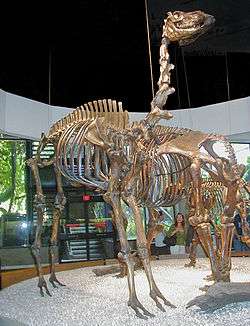 | |
| Mounted skeleton of Camelops hesternus in the George C. Page Museum, Los Angeles | |
| Scientific classification | |
| Kingdom: | Animalia |
| Phylum: | Chordata |
| Class: | Mammalia |
| Order: | Artiodactyla |
| Family: | Camelidae |
| Tribe: | Camelini |
| Genus: | †Camelops Leidy, 1854 |
| Species | |
|
†Camelops kansanus Leidy, 1854
†Camelops hesternus Leidy, 1873 (type) | |
Camelops is an extinct genus of camel that lived in western North America from the middle Pliocene to the end of the Pleistocene. It shares a common ancestor with the Old World Dromedary and Bactrian camel (making it a true camel), as well as a more distant common ancestor with the New World alpaca, guanaco, llama, and vicuña.[1][2] Its name is derived from the Ancient Greek κάμελος (cámelos, "camel")[3] and ὄψ (óps, "face"),[4] i.e. "camel-face".
Taxonomy and evolution
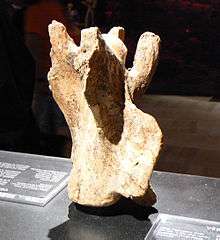
The genus Camelops first appeared during the middle Pliocene (approximately 4.0–3.2 Ma) in southern North America and became extinct at the end of the Pleistocene (approximately 10,000 years ago). Despite the fact that camels are popularly associated with the deserts of Asia and Africa, the family Camelidae, which comprises camels and llamas, originated in North America during the middle Eocene period, at least 44 million years ago.[5] Both the camel and horse families originated in the Americas and migrated into Eurasia via the Bering Strait.[6] Modern camels are descended from the extinct genus Paracamelus, which probably crossed the Bering land bridge into Asia between 7.5 and 6.5 Ma. The divergence between Paracamelus and Camelops occurred about 11–10 Ma. Paracamelus would continue to live in North America as the High Arctic camel until the middle Pleistocene.
During Pleistocene warm periods, a smaller morph of Camelops inhabited Alaska and northern Yukon. These specimens date to around 50–45 ka, and seem to have been extirpated from the area after this time, similar to the contemporaneous mastodon, the ground sloth Megalonyx and the giant beaver Castoroides. The skull of a Camelops specimen was found above the Glenns Ferry Formation in present-day Idaho in a thick layer of coarse gravel known as the Tauna Gravels. Above this layer of gravel is another layer of fine river channel sands, where the skull was found. The age of this fossil is as young as 2 million years old and perhaps even younger, which can be inferred because it is younger than the other fossils found at the Hagerman Fossil Beds National Monument.[7]
During the late Oligocene and early Miocene periods, camels apparently underwent swift evolutionary change, resulting in several genera with different anatomical structures, ranging from those with short limbs, those with gazelle-like bodies, and giraffe-like camels with long legs and long necks. This rich diversity decreased until only a few species, such as Camelops hesternus, remained in North America, before going extinct entirely around 11,000 years ago.[5] By the end of the Pleistocene, with the extinction of Paracamelus and Titanotylopus, Camelops was the only true camel remaining in North America and possibly both Americas. Camelops's extinction was part of a larger North American extinction in which native horses, mastodons and other camelids also died out. Possible causal factors for this megafaunal extinction include global climate change and hunting pressure from human beings. The mass extinction coincided roughly with the appearance of people belonging to the big game-hunting Clovis culture, who were prolific hunters with distinct fluted stone tools, which allowed for a spear to be attached to the stone tool.[5][6] Biochemical analyses have shown that Clovis tools were used in butchering camels.[8]
Description
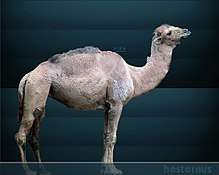
Because soft tissues are generally not preserved in the fossil record, it is not certain if Camelops possessed a hump, like modern camels, or lacked one, like its modern llama relatives. Because one-humped camels are now known to have evolved from two-humped camels, it would follow that Camelops, if it had humps, probably had two, as this would be the more parsimonious view.[9] Camelops hesternus was approximately 2.2 m (7.2 ft) tall at the shoulder, making it slightly taller than modern Bactrian camels; it was also slightly heavier, weighing about 800 kg (1,800 lb).[10]
Palaeobiology
Plant remains found in the teeth of the Rancho La Brea Camelops hesternus fossils further reveal that rather than being limited to grazing, this species likely ate mixed species of plants, including coarse shrubs growing in coastal southern California. Camelops probably could travel long distances, similar to modern camel species. Whether or not Camelops could survive for long periods without water, as with extant camels, is still unknown; this may have been an adaptation that occurred much later, after camelids migrated to Asia and Africa.[11]
Extinction
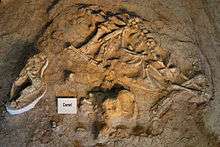
The last species of Camelops are hypothesized to have disappeared as a result of the Blitzkrieg model. This model presents the hypothesis that Camelops, along with other North American megafauna, disappeared as new cultures of experienced and efficient hunters moved southeastward across the continent. The result of this migration and expansion of human populations was a significant reduction in range for the megafauna.[12] Of the many Camelops specimens recovered in North America, mostly in the Wisconsin region, only a small number demonstrate modification through human actions.[13] Some specimens have been interpreted as having been killed by humans based on the presence of spirally fractured bone fragments. None of the reported Camelops sites have been associated with stone tools, however, which would be an indicator of possible human utilization.[13]
At many of these Camelops sites, there were no fossils of carcasses that were evidently processed, but rather small fragments and pieces of remains. Researchers originally thought that Camelops were in fact hunted and butchered by early humans in North America because of the following four reasons: the fragmenting of bones into shapes that look like tools, damage or weathering of the “working” edge of said tools, having attributes that were similar to the making of chopping tools, and scarred fragments from possible chopping tools.[13] Further examination showed however that these assumptions were misguided, and that while humans did coexist and associate with Camelops, human utilization has yet to be completely proven as the sole cause of extinction.[13]
Walmart camel
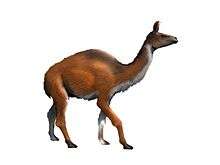
The "Walmart camel" is the fossil of a prehistoric mammal, originally thought to be a camel, found at a Walmart construction site in Mesa, Arizona in 2007. Workers digging a hole for an ornamental citrus tree found the bones of two (juvenile and infant) animals that may have lived about 10,000 years ago.[14] Arizona State University Geology Museum curator Brad Archer called it an important and rare find for the area.[15] Walmart officials and Greenfield Citrus Nursery owner John Babiarz, whose crew discovered the remains, agreed that the bones would go directly to the Geology Museum at Arizona State University where further research and restoration of the fossils could be done. Further studies of the fossil remains proved inconclusive as to their identity as several diagnostic elements of the skeleton were not preserved or were removed from the site during previous excavations in the same area. Other fossils, positively identified as camel bones, were found in Gilbert, Arizona in May 2008.[16][17]
See also
- Syrian camel, an extinct species that reached at least 9 feet (2.7 m) tall at the shoulder
- Pleistocene megafauna
- Snowmastodon Project
References
- ↑ Heintzman, Peter D.; Zazula, Grant D.; Cahill, James A.; Reyes, Alberto V.; MacPhee, Ross D.E.; Shapiro, Beth (2 June 2015). "Genomic Data from Extinct North American Camelops Revise Camel Evolutionary History". Molecular Biology and Evolution. 32 (9): 2433–2440. doi:10.1093/molbev/msv128. Retrieved 9 April 2017.
- ↑ SAITOU, Naruya, and Shayire SHOKAT. "DNA Analyses of Camels." Journal of Arid Land Studies 26, no. 4 (2017): 223-226.
- ↑ κάμηλος. Liddell, Henry George; Scott, Robert; A Greek–English Lexicon at the Perseus Project
- ↑ ὄψ. Liddell, Henry George; Scott, Robert; A Greek–English Lexicon at the Perseus Project
- 1 2 3 "Camelops". Anza-Borrego Desert State Park Paleontology Society. Archived from the original on 2011-09-04.
- 1 2 Hutchinson, Jon (2012-08-14). "Camel Country: Where have all our camelops gone?". Verde Independent.
- ↑ National Park Service. "Camelops". Hagerman Fossil Beds. U.S. Department of the Interior.
- ↑ Scott, J. (2009-02-26). "Camel-butchering in Boulder, 13,000 years ago". Colorado Arts and Sciences Magazine. University of Colorado at Boulder. Archived from the original on 2010-06-10. Retrieved 2009-05-01.
- ↑ "Evolutionary History | Camels". blogs.lt.vt.edu. Retrieved 2018-05-29.
- ↑ "Extinct Western Camel Fact Sheet, 2009". Library.sandiegozoo.org. Retrieved 10 November 2017.
- ↑ Museum, San Diego Natural History. "San Diego Natural History Museum Fossil Mysteries Field Guide: Extinct Camel". Sdnhm.org. Retrieved 10 November 2017.
- ↑ Beck, Michael W. (10 November 1996). "On Discerning the Cause of Late Pleistocene Megafaunal Extinctions". Paleobiology. 22 (1): 91–103. doi:10.2307/2401044. JSTOR 2401044.
- 1 2 3 4 Haynes, Gary; Stanford, Dennis (September 1984). "On the possible utilization of Camelops by early man in North America" (PDF). Quaternary Research. 22 (2): 216–230. doi:10.1016/0033-5894(84)90041-3.
- ↑ Richardson, Christian (April 28, 2007). "Prehistoric camel bones found in Mesa". East Valley Tribune. Archived from the original on 2008-01-07.
- ↑ Associated Press. "10,000-year-old camel bones found in Arizona". MSN. Retrieved 16 January 2011.
- ↑ Markham, Chris (May 25, 2008). "Rare camel fossil unearthed in southeast Gilbert". East Valley Tribune.
- ↑ "Bones of large prehistoric camel found in Gilbert". Azcentral.com. Retrieved 10 November 2017.